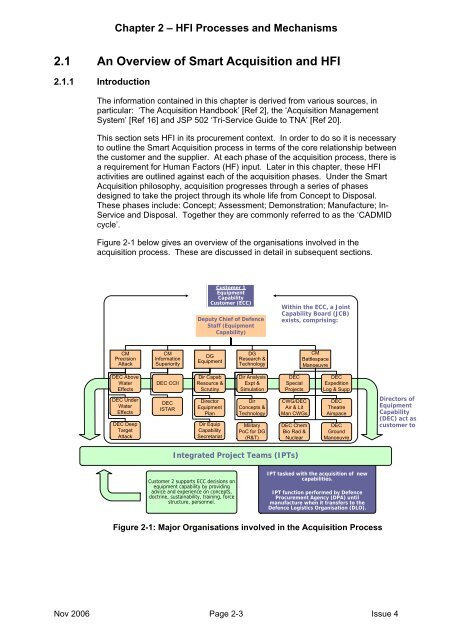MAP-01-010 HFI Management Guide - Human Factors Integration ...
MAP-01-010 HFI Management Guide - Human Factors Integration ...
MAP-01-010 HFI Management Guide - Human Factors Integration ...
Create successful ePaper yourself
Turn your PDF publications into a flip-book with our unique Google optimized e-Paper software.
Chapter 2 – <strong>HFI</strong> Processes and Mechanisms<br />
2.1 An Overview of Smart Acquisition and <strong>HFI</strong><br />
2.1.1 Introduction<br />
The information contained in this chapter is derived from various sources, in<br />
particular: ‘The Acquisition Handbook’ [Ref 2], the ‘Acquisition <strong>Management</strong><br />
System’ [Ref 16] and JSP 502 ‘Tri-Service <strong>Guide</strong> to TNA’ [Ref 20].<br />
This section sets <strong>HFI</strong> in its procurement context. In order to do so it is necessary<br />
to outline the Smart Acquisition process in terms of the core relationship between<br />
the customer and the supplier. At each phase of the acquisition process, there is<br />
a requirement for <strong>Human</strong> <strong>Factors</strong> (HF) input. Later in this chapter, these <strong>HFI</strong><br />
activities are outlined against each of the acquisition phases. Under the Smart<br />
Acquisition philosophy, acquisition progresses through a series of phases<br />
designed to take the project through its whole life from Concept to Disposal.<br />
These phases include: Concept; Assessment; Demonstration; Manufacture; In-<br />
Service and Disposal. Together they are commonly referred to as the ‘CADMID<br />
cycle’.<br />
Figure 2-1 below gives an overview of the organisations involved in the<br />
acquisition process. These are discussed in detail in subsequent sections.<br />
Customer 1<br />
Equipment<br />
Capability<br />
Customer (ECC)<br />
Deputy Chief of Defence<br />
Staff (Equipment<br />
Capability)<br />
Within the ECC, a Joint<br />
Capability Board (JCB)<br />
exists, comprising:<br />
CM<br />
Precision<br />
Attack<br />
CM<br />
Information<br />
Superiority<br />
DG<br />
Equipment<br />
DG<br />
Research &<br />
Technology<br />
CM<br />
Battlespace<br />
Manoeuvre<br />
DEC Above<br />
Water<br />
Effects<br />
DEC CCII<br />
Dir Capab<br />
Resource &<br />
Scrutiny<br />
Dir Analysis<br />
Expt &<br />
Simulation<br />
DEC<br />
Special<br />
Projects<br />
DEC<br />
Expedition<br />
Log & Supp<br />
DEC Under<br />
Water<br />
Effects<br />
DEC Deep<br />
Target<br />
Attack<br />
DEC<br />
ISTAR<br />
Director<br />
Equipment<br />
Plan<br />
Dir Equip<br />
Capability<br />
Secretariat<br />
Dir<br />
Concepts &<br />
Technology<br />
Military<br />
PoC for DG<br />
(R&T)<br />
CWG/DEC<br />
Air & Lit<br />
Man CWGs<br />
DEC Chem<br />
Bio Rad &<br />
Nuclear<br />
DEC<br />
Theatre<br />
Airspace<br />
DEC<br />
Ground<br />
Manoeuvre<br />
Directors of<br />
Equipment<br />
Capability<br />
(DEC) act as<br />
customer to<br />
Integrated Project Teams (IPTs)<br />
Customer 2 supports ECC decisions on<br />
equipment capability by providing<br />
advice and experience on concepts,<br />
doctrine, sustainability, training, force<br />
structure, personnel.<br />
IPT tasked with the acquisition of new<br />
capabilities.<br />
IPT function performed by Defence<br />
Procurement Agency (DPA) until<br />
manufacture when it transfers to the<br />
Defence Logistics Organisation (DLO).<br />
Figure 2-1: Major Organisations involved in the Acquisition Process<br />
Nov 2006 Page 2-3 Issue 4
















